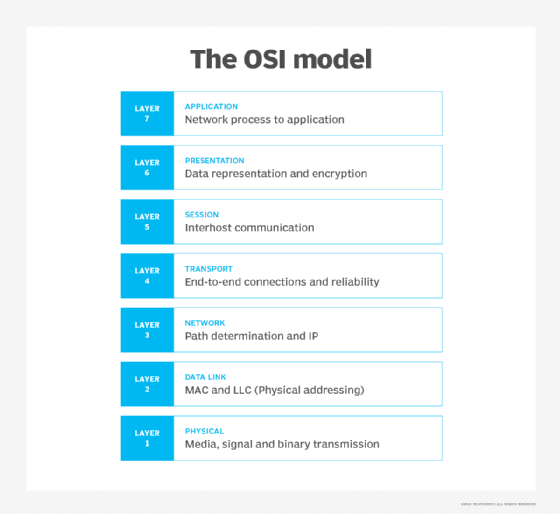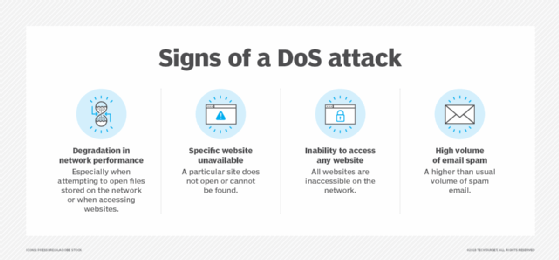Which Of The Following Results In A Denial-of-service (Dos) Attack
What is a denial-of-service attack?
A denial-of-service (DoS) assault is a security threat that occurs when an attacker makes it incommunicable for legitimate users to access reckoner systems, network, services or other information technology (IT) resource. Attackers in these types of attacks typically flood spider web servers, systems or networks with traffic that overwhelms the victim's resources and makes it difficult or impossible for anyone else to access them.
Restarting a arrangement will ordinarily prepare an assail that crashes a server, but flooding attacks are more difficult to recover from. Recovering from a distributed DoS (DDoS) attack in which attack traffic comes from a big number of sources is even more than hard.
DoS and DDoS attacks often take advantage of vulnerabilities in networking protocols and how they handle network traffic. For example, an attacker might overwhelm the service by transmitting many packets to a vulnerable network service from dissimilar Internet Protocol (IP) addresses.
How does a DoS attack work?
DoS and DDoS attacks target one or more of the vii layers of the Open up Systems Interconnection (OSI) model. The almost mutual OSI targets include Layer 3 (network), Layer 4 (send), Layer 6 (presentation) and Layer seven (awarding).

Malicious actors have unlike means of attacking the OSI layers. Using User Datagram Protocol (UDP) packets is one common fashion. UDP speeds manual transferring data before the receiving political party sends its agreement. Some other mutual attack method is SYN (synchronization) package attacks. In these attacks, packets are sent to all open ports on a server, using spoofed, or fake, IP addresses. UDP and SYN attacks typically target OSI Layers iii and iv.
Protocol handshakes launched from internet of things (IoT) devices are now commonly used to launch attacks on Layers half dozen and 7. These attacks can exist difficult to identify and preempt because IoT devices are everywhere and each is a discrete intelligent client.
Signs of a DoS attack
The Usa Calculator Emergency Readiness Squad, also known as United states of america-CERT, provides guidelines to make up one's mind when a DoS attack may exist in progress. According to US-CERT, the following may indicate an attack is underway:
- slower or otherwise degraded network operation that is particularly noticeable when trying to admission a website or open files on the network;
- inability to access a website; or
- more spam email than usual.

Preventing a DoS attack
Experts recommend several strategies to defend against DoS and DDoS attacks, starting with preparing an incident response plan well in advance.
An enterprise that suspects a DoS attack is underway should contact its internet access provider (ISP) to make up one's mind whether slow performance or other indications are from an set on or another factor. The Internet service provider can reroute the malicious traffic to counter the assault. It can also utilize load balancers to mitigate the severity of the attack.
ISPs too accept products that detect DoS attacks, every bit do some intrusion detection systems (IDSes), intrusion prevention systems (IPSes) and firewalls. Other strategies include contracting with a backup ISP and using cloud-based anti-DoS measures.
There have been instances where attackers have demanded payment from victims to end DoS or DDoS attacks, simply financial profit is not usually the motive behind these attacks. In many cases, the attackers wish to harm the business organisation or reputation of the organization or individual targeted in the attack.
Types of DoS attacks
DoS and DDoS attacks take a variety of methods of attack. Common types of deprival-of-service attacks include the following:
- Application layer. These attacks generate faux traffic to net application servers, specially domain name arrangement (DNS) servers or Hypertext Transfer Protocol (HTTP) servers. Some awarding layer DoS attacks flood the target servers with network data; others target the victim's application server or protocol, looking for vulnerabilities.
- Buffer overflow . This type of assault is one that sends more traffic to a network resource than it was designed to handle.
- DNS distension . In a DNS DoS assault, the attacker generates DNS requests that appear to have originated from an IP address in the targeted network and sends them to misconfigured DNS servers managed past tertiary parties. The distension occurs as the intermediate DNS servers reply to the fake DNS requests. The responses from intermediate DNS servers to the requests may contain more data than ordinary DNS responses, which requires more resources to process. This can result in legitimate users being denied access to the service.
- Ping of decease . These attacks corruption the ping protocol by sending request letters with oversized payloads, causing the target systems to become overwhelmed, to terminate responding to legitimate requests for service and to perchance crash the victim'south systems.
- State exhaustion. These attacks -- also known every bit Transmission Control Protocol ( TCP) attacks -- occur when an assailant targets the state tables held in firewalls, routers and other network devices and fills them with set on data. When these devices incorporate stateful inspection of network circuits, attackers may exist able to fill the state tables past opening more than TCP circuits than the victim's arrangement can handle at one time, preventing legitimate users from accessing the network resource.
- SYN flood . This set on abuses the TCP handshake protocol by which a client establishes a TCP connection with a server. In a SYN flood assail, the attacker directs a high-volume stream of requests to open TCP connections with the victim server with no intention of completing the circuits. A successful attack tin can deny legitimate users access to the targeted server.
- Teardrop. These attacks exploit flaws like how older operating systems (OSes) handled fragmented IP packets. The IP specification enables packet fragmentation when the packets are likewise large to exist handled by intermediary routers, and it requires packet fragments to specify fragment offsets. In teardrop attacks, the fragment offsets are set to overlap each other. Hosts running affected OSes are then unable to reassemble the fragments, and the attack can crash the system.
- Volumetric. These DoS attacks employ all the bandwidth available to reach network resources. To do this, attackers must straight a high volume of network traffic at the victim'due south systems. Volumetric DoS attacks inundation a victim's devices with network packets using UDP or Net Command Message Protocol (ICMP). These protocols require relatively little overhead to generate large volumes of traffic, while, at the same time, the victim's network devices are overwhelmed with network packets, trying to procedure the incoming malicious datagrams.
What is DDoS and how does it compare to DoS?
Many high-profile DoS attacks are really distributed attacks, where the assault traffic comes from multiple attack systems. DoS attacks originating from one source or IP address tin be easier to counter considering defenders can block network traffic from the offending source. Attacks from multiple attacking systems are far more difficult to detect and defend confronting. It tin can exist difficult to differentiate legitimate traffic from malicious traffic and filter out malicious packets when they are beingness sent from IP addresses seemingly located all over the internet.
In a distributed deprival-of-service attack, the attacker may utilize computers or other network-connected devices that have been infected by malware and fabricated office of a botnet. DDoS attacks use command-and-command servers (C&C servers) to control the botnets that are function of the set on. The C&C servers dictate what kind of assail to launch, what types of data to transmit, and what systems or network connectivity resource to target with the attack.
History of deprival-of-service attacks
DoS attacks on internet-continued systems have a long history that arguably started with the Robert Morris worm attack in 1988. In that attack, Morris, a graduate student at Massuchusetts Institute of Engineering science (MIT), released a cocky-reproducing piece of malware -- a worm -- that chop-chop spread through the internet and triggered buffer overflows and DoS attacks on the affected systems.
Those connected to the internet at the time were mostly research and academic institutions, but it was estimated that as many as x% of the 60,000 systems in the U.Due south. were affected. Impairment was estimated to be as high as $10 million, according to the U.S. Full general Accounting Function (GAO), now known as the Authorities Accountability Function. Prosecuted under the 1986 Computer Fraud and Abuse Human activity (CFAA), Morris was sentenced to 400 community service hours and three years' probation. He was as well fined $x,000.
DoS and DDoS attacks have go common since then. Some contempo attacks include the post-obit:
- GitHub. On Feb. 28, 2018, GitHub.com was unavailable because of a DDoS attack. GitHub said it was offline for under ten minutes. The attack came "beyond tens of thousands of endpoints … that peaked at 1.35 terabits per second (Tbps) via 126.9 million packets per second," according to GitHub.
- Imperva. On April 30, 2019, network security vendor Imperva said it recorded a large DDoS attack against one of its clients. The attack peaked at 580 million packets per 2d but was mitigated by its DDoS protection software, the company said.
- Amazon Spider web Services (AWS). In the AWS Shield Threat Landscape Report Q1 2020, the cloud service provider (CSP) said it mitigated one of the largest DDoS attack it had e'er seen in February 2020. It was 44% larger than anything AWS had encountered. The volume of the attack was 2.3 Tbps and used a type of UDP vector known equally a Connection-less Lightweight Directory Admission Protocol (CLDAP) reflection. Amazon said it used its AWS Shield to counter the attack.
This was last updated in April 2021
Continue Reading Almost denial-of-service set on
- 6 common types of cyber attacks and how to prevent them
- The ultimate guide to cybersecurity planning for businesses
- 10 types of security incidents and how to handle them
- Credential stuffing: When DDoS isn't DDoS
- The dark spider web in 2021: Should enterprises be worried?
Dig Deeper on Network security
-

Implement API charge per unit limiting to reduce attack surfaces
-

IP spoofing
-

distributed denial-of-service (DDoS) attack
-
![]()
3 means to prevent DDoS attacks on networks
Source: https://www.techtarget.com/searchsecurity/definition/denial-of-service
Posted by: baumfivemplarity69.blogspot.com






0 Response to "Which Of The Following Results In A Denial-of-service (Dos) Attack"
Post a Comment